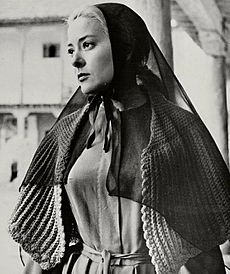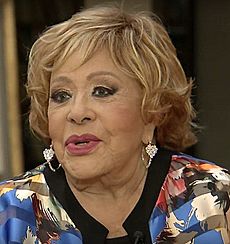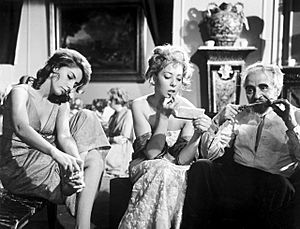Silvia Pinal facts for kids
Quick facts for kids
Silvia Pinal
|
|
|---|---|
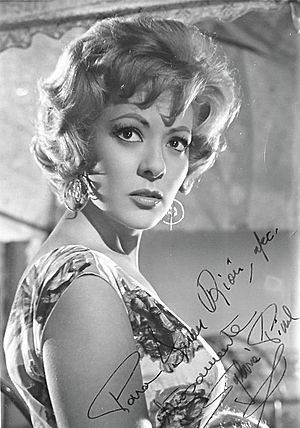
Pinal in Maribel y la extraña familia (1960)
|
|
| Born |
Silvia Pinal Hidalgo
12 September 1931 |
| Died | 28 November 2024 (aged 93) Mexico City, Mexico
|
| Education | National Institute of Fine Arts and Literature |
| Occupation | Actress, singer, stage and television producer, politician |
| Years active | 1949–2022 |
| Political party | Institutional Revolutionary Party |
| Spouse(s) |
Rafael Banquells
(m. 1947; div. 1952)Gustavo Alatriste
(m. 1961; div. 1967)Tulio Hernández
(m. 1982; div. 1995) |
| Children | 4, including
|
| Senator of the Republic | |
| In office 1997–2000 |
|
| Member of the Chamber of Deputies | |
| In office 1 September 1991 – 31 August 1994 |
|
| Constituency | Mexico City's 27th district |
Silvia Pinal Hidalgo (12 September 1931 – 28 November 2024) was a famous Mexican actress. She started her career in theater and then moved into movies in 1949. Silvia Pinal was one of Mexico's biggest female stars, especially during the Golden Age of Mexican cinema. She even worked in Hollywood for her film Shark! (1969). Because she was so popular in Mexico, Pinal also worked in Europe, especially in Spain and Italy. She became famous around the world for starring in three important films directed by Luis Buñuel: Viridiana (1961), El ángel exterminador (1962), and Simón del desierto (1965).
Besides her movie career, Pinal was a pioneer in Mexican musical theatre. She also worked in television and held political jobs. Many people considered her the last "diva" from Mexico's Golden Age of film.
Contents
Early Life and Dreams
Silvia Pinal Hidalgo was born in Guaymas, Sonora, Mexico. Her mother was María Luisa Hidalgo Aguilar. Silvia's mother later married Luis G. Pinal, a journalist and politician. He adopted Silvia, and she always thought of him as her only father.
Silvia's family moved to many cities in Mexico, like Querétaro and Mexico City. From a young age, Silvia loved show business. She enjoyed movies, music, writing, and reciting poems. She went to college and also learned to type. At 14, she started working as a secretary at Kodak.
Silvia wanted to sing opera and took classes. She also entered a beauty contest and won the title of Student Princess of Mexico. This is where she met actors Rubén Rojo and Manolo Fábregas. Later, she took acting classes at the Instituto Nacional de Bellas Artes. She got her first acting role as an extra in a play called A Midsummer Night's Dream.
Becoming a Star
Starting in Radio and Theater
Silvia Pinal kept working as a secretary while studying acting. Her boss let her join radio comedies for station XEQ. She then joined an experimental theater group. Her first play with them was Los Caprichos de Goya. The director was Rafael Banquells, who later became her husband.
Silvia quickly became a popular actress in theater. She acted in many plays, and her first main role was in Un sueño de cristal.
Making Movies
Just two weeks after her first play, Silvia Pinal made her movie debut in Bamba (1949). The director, Miguel Contreras Torres, saw her acting in the theater. She then worked with Rafael Banquells in El pecado de Laura.
Pinal's career grew quickly. She worked with famous actors like Pedro Infante in La mujer que yo perdí. The famous comedian Cantinflas chose her to co-star in The Doorman (1950), which was a big step for her. She also became a great comedy partner with Germán Valdés "Tin-Tán" in El rey del barrio (1949).
Silvia won her first big award, a Silver Ariel, for her role in Un rincón cerca del cielo (1952). In 1953, she got her first main roles in films like Reventa de esclavas. She also starred in musical films such as Mis tres viudas alegres.
In 1954, Pinal became a top movie star after her role in Un extraño en la escalera. She starred with Arturo de Córdova in this very successful film. She also won another Silver Ariel for Best Actress for her role in Locura pasional (1955).
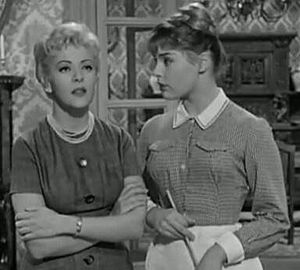
Silvia's popularity in Mexico led her to work in Europe. She made films in Spain and Italy, including Las locuras de Bárbara (1958) and Uomini e Nobiluomini (1959).
Working with Luis Buñuel
Silvia Pinal became internationally famous for three films with the Spanish director Luis Buñuel. With the help of her second husband, Gustavo Alatriste, she convinced Buñuel to film Viridiana (1961). This movie is her most famous and won the top prize, the Palme d'Or, at the Cannes Film Festival. Even though it was successful, the film was banned in Spain and by the Vatican because they thought it was disrespectful. Silvia Pinal saved a copy of the film by taking it to Mexico.
Her second film with Buñuel was El ángel exterminador (1962). This movie also received great reviews worldwide. The New York Times even called it one of the best films ever.
Her third and last film with Buñuel was Simón del desierto (1964). Silvia Pinal was one of the actresses who worked most often with Buñuel, making three classic films together.
Later Film Work
After working with Buñuel, Pinal continued making movies. She starred in La Soldadera (1966), inspired by the Mexican Revolution. She also appeared in the international film La bataille de San Sebastian with Anthony Quinn and Charles Bronson. In 1967, Pinal was in Shark! with Burt Reynolds, which was her only Hollywood movie.
She had a huge hit with María Isabel (1968), based on a popular comic. Later, she starred in Las mariposas disecadas (1976), a suspense thriller. In 1977, she finally starred in the movie Divinas palabras.
In the 1990s, Silvia Pinal returned to cinema with Modelo Antiguo (1992). Her later movie appearances were brief, as she focused more on television and politics.
On Stage
Silvia Pinal started her theater career at the Instituto Nacional de Bellas Artes. She quickly became a well-known stage actress. In 1958, Pinal produced Mexico's first musical comedy, Bells Are Ringing. She was even offered a role on Broadway in New York, but she chose to stay in Mexico.
One of her most famous musical roles was in the Mexican version of Mame. She starred in this successful Broadway musical three times (1972, 1985, and 1989). In 1976, she also starred in Annie Get Your Gun.
In 1988, Pinal bought a movie theater and turned it into the Silvia Pinal Theater, mainly for musical comedies. She also opened a second theater, the Diego Rivera Theater, in 1991. As a producer, she brought musicals like A Chorus Line (1989) and Cats (1991) to Mexico.
Her last major theater role was in Gypsy (1998), where she starred with her daughter, Alejandra Guzmán.
Television Work
Silvia Pinal started working in television in Mexico in the early 1950s. She had her own comedy-musical show called Silvia y Enrique (1968–1972) with her husband, Enrique Guzmán.
In 1985, she became the producer and host of the TV show Mujer, casos de la vida real. This show helped people after the 1985 earthquake in Mexico City. Over time, it showed stories about daily life, like family issues and health. The program was very successful and ran for over 20 years.
Pinal also acted in and produced telenovelas (Mexican soap operas). Her first big hit as a producer was Mañana es primavera (1982). She also appeared in many other telenovelas, including Carita de ángel (2000) and Soy tu dueña (2010).
In Politics
Silvia Pinal became involved in politics after marrying politician Tulio Hernández Gómez, who was the governor of the State of Tlaxcala. From 1981 to 1987, she served as the First Lady of Tlaxcala.
She became a member of the Institutional Revolutionary Party. In 1991, she was elected to the Chamber of Deputies. From 1997 to 2000, she was a senator. In these roles, Pinal worked to protect the rights of performers in film. She also helped with laws about tourism and fought to lower taxes on theater.
Pinal was also active in groups that supported actors. She led the National Association of Interpreters (ANDI) from 1988 to 1995. Later, from 2010 to 2014, she was the General Secretary of the National Association of Actors (ANDA).
She founded the Asociación Rafael Banquells to help older actors. As president of this group, Pinal gave out the Bravo Awards each year to recognize achievements in music, film, theater, and television.
Family Life and Passing
Silvia Pinal was married four times. Her first marriage was to actor Rafael Banquells in 1947. They had a daughter, Sylvia Pasquel, who also became an actress.
Her second marriage was to producer Gustavo Alatriste. They had a daughter, Viridiana Alatriste. Sadly, Viridiana died in a car accident in 1982 at age 19.
Her third marriage was to rock and roll singer Enrique Guzmán. They were married for nine years and had two children: singer Alejandra Guzmán and musician Luis Enrique Guzmán.
Her last marriage was to politician Tulio Hernández Gómez. They married in 1982.
Silvia Pinal became the head of one of Latin America's most famous artistic families. Her daughters Sylvia and Viridiana became actresses. Her youngest daughter, Alejandra, is a very popular singer. Her granddaughters, Stephanie Salas and Camila Valero, and great-granddaughter, Michelle Salas, are also models and actresses.
In November 2024, Silvia Pinal was hospitalized for an infection. She passed away on 28 November 2024, at 93 years old. Many people honored her life and career, including the Mexican Senate and the Secretariat of Culture.
Awards and Recognition
- In 1956, the famous artist Diego Rivera painted a portrait of Silvia Pinal.
- She is shown as one of the Seven Muses of Art in a stained glass window at the Teatro Xicohténcatl in Tlaxcala.
- In 2002, a statue of Silvia Pinal was unveiled in Mexico City to honor her.
- In 2006, she received the Orden de Isabel la Católica from Spain for her contributions to cinema.
- She published her autobiography, Esta soy yo, in 2015.
- In 2016, the Academy of Motion Picture Arts and Sciences in Hollywood invited Pinal to be a member, recognizing her long career in international film.
Selected Filmography
Movies
Silvia Pinal starred in many films throughout her career, including:
- Viridiana (1961)
- El ángel exterminador (1962)
- Simón del desierto (1965)
- Shark! (1969)
- El rey del barrio (1950)
- El inocente (1956)
- María Isabel (1968)
- Divinas palabras (1977)
Television Shows
Silvia Pinal was a pioneer in Mexican television. Some of her notable TV works include:
- Mujer, casos de la vida real (1986–2007) - Host and producer
- Silvia Pinal, frente a ti (2019) - Herself (biographical series)
- Mi marido tiene familia (2017–2019) - Doña Imelda Sierra Vda. de Córcega
- Mañana es primavera (1983) - Amanda González de Serrano (also producer)
- Silvia y Enrique (1968–1972) - Herself (variety show)
Stage Plays
Silvia Pinal had a long and successful career in theater. Some of her famous stage roles include:
- Bells Are Ringing (1958)
- Mame (1972, 1985, 1989)
- Annie Get Your Gun (1976)
- Hello Dolly! (1996)
- Gypsy (1998)
Stage (as Producer)
As a producer, Silvia Pinal brought several major musicals to the Mexican stage:
- A Chorus Line (1989)
- Cats (1991)
- La Cage aux Folles (1993)
Images for kids
See also
 In Spanish: Silvia Pinal para niños
In Spanish: Silvia Pinal para niños


